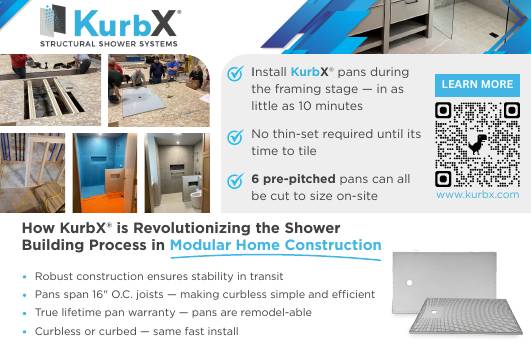
Let’s Break Through Modular’s Bottleneck
The future of modular construction belongs to those who create collaborative ecosystems of suppliers, factories and builders. And it’s already happening.
US modular manufacturers deliver an impressive range of products, from simple home designs to complex commercial buildings. However, they operate mostly in silos, with each company narrowly focused on a specific project type. This is slowing modular’s growth.
For instance, a manufacturing facility that specializes in single-family housing for residential developers might not know how to bid on housing for a military base, even if the homes that base needs are within its capacity to build. If that same factory partnered with a company in the multifamily space, they could go after this, as well other large, sophisticated projects.
Such coordination is what’s needed to scale modular construction to its full potential and break through modular’s bottleneck, but it will require a mindset shift, as well as integrators that coordinate the different entities across the various silos.
The mindset shift we need is to what I call Platform Thinking: a system that links independent manufacturers together into coordinated, scalable networks. These networks would enhance cost and schedule savings, while expanding opportunities for everyone involved. They could transform the industry.
Take the example of supply chain leverage. Most modular manufacturers procure materials at modest volumes and with limited negotiating power. A coordinated procurement effort would increase bargaining leverage with suppliers — enabling cost reductions through bulk purchasing.
Shared knowledge across such a network could also unlock new capabilities — whether troubleshooting novel installation conditions or jointly investing in innovative systems like zoned HVAC or high-efficiency mechanical pods. We can all learn from one another.
The network would even address capacity constraints. Projects could be routed to peer manufacturers under a structured referral mechanism — supported by incentive-sharing agreements. This would help individual factories capture otherwise lost revenue and would strengthen market responsiveness across the entire network.
Factories that were previously trapped in a silo would have opportunities to participate in larger, mixed-use development projects that combine housing, commercial and institutional elements. Most modular manufacturers are equipped to deliver only part of that scope, but a network of manufacturers with complementary competencies could offer a credible, full-spectrum alternative.
Cost savings would also be enhanced. A 2023 field study by the University of Nebraska found that modular multifamily projects are already saving money, with an average of $243 per sq. ft. in build costs, compared to $251 per sq. ft. for site-built (roughly 4% less). Additionally, a 2020 report by Dodge Data & Analytics ( SmartMarket Report: Prefabrication and Modular Construction)found that 48% of contractors reported cost reductions greater than 10%, and 68% saw budget improvements of more than 5% with modular. The network approach could increase these savings.
Schedule benefits are even more pronounced: According to the Modular Building Institute’s “2024 Permanent Modular Construction Report”, modular reduces timelines by 30% to 50%, thanks to the parallel progress of site work and factory production.

Why Hasn’t It Happened Yet?
The biggest obstacle to a networked modular ecosystem is a misalignment of incentives between what individual companies want and what delivers optimal outcomes for projects as a whole. For instance, general contractors (GCs) collect multiple bids that pit manufacturers against one another, prioritizing short-term cost savings over long-term relationship building.
The challenge is compounded by the lack of standardized components or interoperable design platforms across manufacturers. When multiple manufacturers attempt to collaborate, they often use different modules, assemblies and documentation. This slows delivery, raises costs and limits the ability to pool resources.
These systemic gaps help explain why modular construction still holds only 6.64% of the total North American market share for new construction starts, despite its clear advantages. Without coordination mechanisms and shared operating models, most manufacturers remain boxed out of the broader opportunity landscape.

The Integrator Function
Overcoming these systemic constraints requires infrastructure. Specifically, the modular sector needs one or more formalized integrators: individuals or teams who are fluent in modular workflows, developer expectations and government priorities. I’m not talking about traditional general contractors or supply chain aggregators, but about purpose-built intermediaries with the mandate to enable seamless cooperation at scale.
This is more than an idea: A few companies are already starting down this road. ADL Ventures, the company I work for, is working on building an integrator function and will be using a small development in North Carolina as a test case. We are in discussions with a network of manufacturers (Module, Eco Panels and Cardinal Homes, to name a few) about creating the needed manufacturer network. Some nonprofits and government agencies are also working on the idea.
Integrators can develop shared protocols — digital file formats, transport specs, QA/QC benchmarks — that allow manufacturers to pool capacity and support each other on complex builds. They can also manage lead-sharing, knowledge transfer, shared services (energy raters for example) and serve as a unified voice with regulators.
Other industries — automotive and cloud computing, for example — have long embraced this kind of integration, so we know it works. If modular is to grow it must do the same.
From Vision to Execution
The point of this article is to show that the modular industry doesn’t lack potential — it lacks coordination. The capabilities are in place. The need is clear. What’s missing is a network model that brings manufacturers together, aligns incentives and enables delivery at scale.

The longer we wait, the more ground we lose to legacy systems that aren’t built for speed, sustainability, or resilience. It’s time to move from fragmented innovation to collective execution. A modular network isn’t just a smart idea — it’s a competitive necessity, and companies that want to grow need to start collaborating and sharing resources. Those that do will shape the future of construction.

Ankur Dobriyal is an expert in sustainable industrialized construction (IC). He excels in project management and strategy, has managed pre-construction and budgeting for mixed-income modular homes, and led the launch of a regional ‘last-mile’ modular factory. He now oversees key Industrialized Construction projects for ADL Ventures’ buildings practice.
















